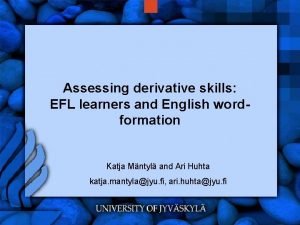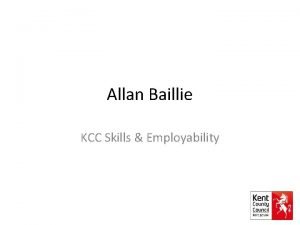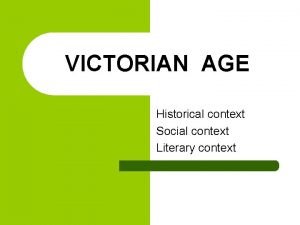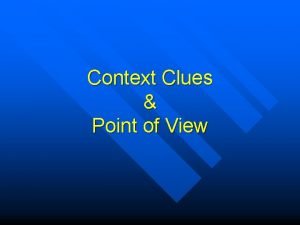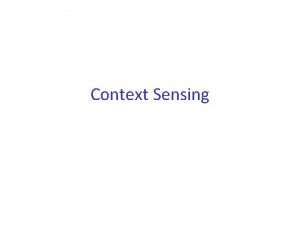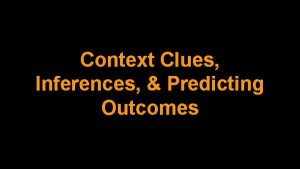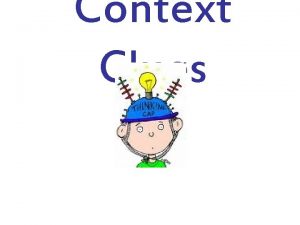Adult Skills in the Context of Skill Formation





























- Slides: 29

Adult Skills in the Context of Skill Formation Across the Life-Cycle Pedro Carneiro University College London, Institute for Fiscal Studies, Centre for Microdata Methods and Practice April 2009 1

Adult Skills, Inequality and Economic Growth n When we talk about skills and the economy we think about the productivity of the workforce, inequality, poverty (and a few other things). n In this context I would like to alert you to two problems in modern economies: Slowdown in the growth of educational attainment n Changing nature of economic growth and implications for poverty n 2

Slowdown in Growth of Educational Attainment 3

Low Skills, Inequality and Poverty Log GDP 11. 2 11 10. 8 10. 6 10. 4 10. 2 10 9. 8 9. 6 9. 4 1958 1968 1978 1988 Year 1998 2008 2018 4

(Modern) Growth Benefits the Top – Low Skilled at the Bottom 5

Large Fraction of Illiterate Adults, without parallel in Europe 6

Policies to Foster Human Capital n Stagnation in growth of educational attainment, even with rising returns to investments in education. n Sharp increase in inequality, stagnation of incomes at the bottom (unemployment. . . ), large proportion of low skilled. n Need to understand causes of skill problem. And in order to design policy, need to understand technology of skill formation. 7

Adult Skills are the result of a lifetime of investments n Start in utero (development of brain) n It is remarkable how events in utero or shortly after birth can have long lasting consequences n Continue well beyond the school years. n Most of our productive skills are acquired on the job. n There is a strong link across stages of a person’s life – requires integrated view of education policy over the life-cycle. The effectiveness of adult investments depends on history of past investments. 8

Influenza Pandemic – Fall 1918 9

Maternity Leave in Norway 10

Multiple Skills n Considerable emphasis on cognitive achievement. Much less emphasis on other types of skill (say, non-cognitive), such as: persistence, discipline, patience. . . n But these other types of skills: Are important for a wide range of measures of adult success n Can be affected by interventions n 11

Ex: GED (High School Equivalency for Dropouts) 12

GEDs do poorly in labor market 13

GEDs are troublemakers 14

Schools, Firms. . . And Families n Parental education, family income, family structure, and similar variables, are the best predictors of school performance. n How to involve families in education policy? n Challenge for poor children: n Center Based – Perry Pre-School (Sure Start) n Home Visits - Jamaica 15

Gaps in Cognitive Skills by SES Emerge Early and Persist 16

Gaps in Non-Cognitive Skills by SES Emerge Early and Persist 17

Flip side: improvements in the education of current generation will translate into better parenting for future generations. Impact of Increasing (Black) Mother’s Education by one year on: Math (age 12) 0. 080 (0. 028) Behavior Problems (age 12) -0. 099 (0. 039) Grade Repetition -0. 065 (0. 016) Reading to Child ¾ Times a Week 0. 054 (0. 018) Own Computer 0. 065 (0. 019) Adult at Home at All Times 0. 051 (0. 017) 18

Plasticity – Sensitive and Critical Periods of Learning n There is some plasticity in the ability to learn at different ages, but it is very far from infinite. For some skills, sensitive and critical periods of learning occur very early in life. n Several examples from humans and animals: Early Affiliative Bond Disruption in Monkeys (maternal removal at 1 and 6 months) n Intensive Early Grooming of Rats n Language Acquisition n Cataracts in Mammals (change in brain architecture) n 19

Evidence from Social Programs n Different degrees of plasticity for different skills. IQ fairly stable very early in life and hard to change. Behavior more malleable until later ages. n We observe this in early childhood and adolescent interventions (enormous gains on crime prevention, and engagement in risky behaviors; more limited gains on cognition). n If we do not want to miss critical and sensitive periods of learning then invest early. If we miss them, some things can be remediated, but behavioral skiils seem more malleable than cognitive skills. n Yet another argument for emphasizing the 20 importance of non-cognitive skills.

Skill Begets Skill n Adult learning builds on learning in adolescence, which in turn builds on learning in childhood: investments early in life increase the productivity of later investments. n Flip side: if skill is not accumulated early on the costs of remediation can be (prohibitively? ) high – it is difficult to learn if there is not a solid ground on which to build. n Conversely, investments early in life will not flourish if they are not followed up by subsequent investments. 21

Evidence (some examples) n Early skills increase product of later investments: Returns to education higher for high ability children. True in US, Sweden, Norway. UK? n Private job training is taken up by the most educated and able works in the firm (true in UK, US). These are the workers for whom returns are likely to be the largest. n n But need to follow up early investments: n Head Start 22

Head Start – No Effects for Blacks? 23

No. . . Much Larger Fade-Out for Blacks (who attend poor schools) 24

In Summary: n Skill formation is a life-cycle process n There are multiple skills n Schools, firms, families are equal partners n Plasticity n Dynamic Complementarity n Two applications: n Failure of public job training programs n Importance of credit constraints for access to higher education 25

SES Gaps in College Attendance 26

College Attendance by Ability and Family Income 27

Gaps Diminished When Take Family Factors Into Account 28

Main Predictor of College Attendance are Cognitive Skills 29
 What are the skills
What are the skills Monadate
Monadate Formation initiale vs formation continue
Formation initiale vs formation continue High context vs low context culture ppt
High context vs low context culture ppt High context vs low context culture ppt
High context vs low context culture ppt Constancy under negation examples
Constancy under negation examples Contoh komunikasi high context dan low context
Contoh komunikasi high context dan low context Intrapersonal skill
Intrapersonal skill Ontario skills passport
Ontario skills passport Hát kết hợp bộ gõ cơ thể
Hát kết hợp bộ gõ cơ thể Bổ thể
Bổ thể Tỉ lệ cơ thể trẻ em
Tỉ lệ cơ thể trẻ em Gấu đi như thế nào
Gấu đi như thế nào Tư thế worm breton
Tư thế worm breton Bài hát chúa yêu trần thế alleluia
Bài hát chúa yêu trần thế alleluia Các môn thể thao bắt đầu bằng tiếng chạy
Các môn thể thao bắt đầu bằng tiếng chạy Thế nào là hệ số cao nhất
Thế nào là hệ số cao nhất Các châu lục và đại dương trên thế giới
Các châu lục và đại dương trên thế giới Công thức tiính động năng
Công thức tiính động năng Trời xanh đây là của chúng ta thể thơ
Trời xanh đây là của chúng ta thể thơ Mật thư tọa độ 5x5
Mật thư tọa độ 5x5 101012 bằng
101012 bằng Phản ứng thế ankan
Phản ứng thế ankan Các châu lục và đại dương trên thế giới
Các châu lục và đại dương trên thế giới Thơ thất ngôn tứ tuyệt đường luật
Thơ thất ngôn tứ tuyệt đường luật Quá trình desamine hóa có thể tạo ra
Quá trình desamine hóa có thể tạo ra Một số thể thơ truyền thống
Một số thể thơ truyền thống Cái miệng nó xinh thế
Cái miệng nó xinh thế Vẽ hình chiếu vuông góc của vật thể sau
Vẽ hình chiếu vuông góc của vật thể sau

